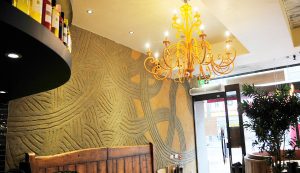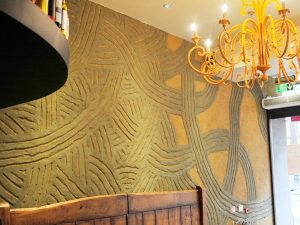Clay plasters are beautiful alright – see Clayworks’ efforts in a restaurant in London (above), and see here for more about clay plasters. But for those of you who want more evidence for the benefits of clay plasters, Adam has compiled the information below, together with sources. This article is about the environmental benefits of clay plasters, and it follows an article outlining the health benefits. We’d like to see a shift from gypsum plasters towards clay plasters, and therefore we feel that it’s important for people to understand that there is scientific data backing up the benefits of clay plaster.
Sustainable products, made in the UK
Claypod™. Clay is one of the most abundant raw materials in the world. In 2010, Clayworks developed Claypod™, a concept, which acts to localise production of unfired clay-based building materials. In terms of clay block masonry and base coat clay plasters, unfired clay experts should have the capability to identify and convert available and suitable raw material, wherever it is found. We also developed a protocol to convert waste and secondary stream clay into valuable material.
Environmental fundamentals
Providers of unfired clay products should endeavour to source as sustainably and as locally as they can. The following is achieveable:
• 100% bio-degradeable
• 100% recyclable
• 100% reusable
Environmental specifics
Embodied energy is a valid way to assess the environmental impact of a (manufactured) product. The most relevant survey we have come across is the ‘Inventory of Carbon & Energy (ICE)’ (see footnote 11). We have formed a graph based on some relevant comparison materials we found in the ICE. Against these, we have used the EE (Mj/kg) figures for the composite materials for clay blocks and base coat clay plasters, found by Busbridge (see footnote 9). From this, we have extracted the materials that help form comparisons against products from unfired clay. This is helpful to suggest the embodied energy of clay blocks and base coat plasters, where they can be sourced and converted, on site:

greenspec.co.uk/embodied-energy.php carries a shorter, more digestible version
Another useful paper to have come from Centre for Alternative Technology (CAT) on embodied energy is that of Carol Atkinson, MSc Architecture: Advanced Environmental and Energy Studies Energy Assessment of a Straw Bale Building, Jan 2008. Carol lists the measurements she took (kWh/m³) of all the constituent materials. The clay plasters were sourced/made in Yorkshire and included hemp.

Full paper here.
Commercial relevance of unfired clay products
Critical aspects of the Code for Sustainable Homes (CfSH) are making their way into UK Building Regulations. An example of this, is Part L, with implications for core building units, which cannot be recycled. Products that are recyclable with low embodied and carbon energies and which reduce the need for energy, can only become more the case, rather than the exception. Considering the credentials of unfired clay products, we predict that they could be remarkably productive inside contemporary building design.
Potential cost savings of unfired clay materials over conventional building materials
Given the implication of CfSH, the true ‘cost’ of a product to the consumer, must be measured beyond mere face value ‘unit’ price. In the same way that locally sourced, organic food more accurately reflects the true price of food, we can suggest that products and concepts in unfired clay are priced appropriately and allow for adoption within the mainstream market. Admittedly, producers of sustainable building materials cannot currently enjoy the economies of scale achieved by large and highly leveraged corporates.
Unit prices start at a moderate, but affordable premium to conventional, high carbon materials. But considering the wider context, and the related cost savings you are also ‘buying’, when choosing a building designed with unfired clay and clay plaster, for instance:
- Reduce/replace use of ventilation systems/extractor fans and associated maintenance/repair costs
- Zero to landfill – unfired clay products can be 100% bio-degradable
- Saving on energy/heating bills through the evening out of temperature swings (see below)
- Savings on resistance to building overheating through thermal mass effect
In the case where unfired clay is used in the form of bricks this material forms a good body of thermal mass, which helps to even out temperature swings. However, even a 15mm plaster coat has significant thermal mass to store heat (see footnote 13) Morton T. et al. According to this same research by Tom Morton et al, the physical mass of clay plaster (20.6 kg/m²) with that of gypsum plaster (8kg/m²) as 2.5 times of the latter. According to Borer and Harris (see footnote 14) the denser building materials perform better in storing heat, with dense soil as the best performer in comparison with other building materials such as fired brick, concrete and stone (Borer and Harris, 1998). N.B. Clayworks Top Coat clay plaster has a density of 1900kg/m³ as opposed to the 1370kg/m³ of the clay plaster in these tests.
Specific comments we have come across:
- Hygroscopic materials contribute to thermal comfort thereby permitting smaller heating systems. The walls will absorb and store heat and moisture, buffering against temperature and humidity fluctuations. Mechanical ventilation systems can be eliminated. (Ruth Busbridge, MSc Jan 2009, footnote 9)
- A porous wall will absorb this moisture and release it when the room is aired during the day, giving a lower average RH. This will reduce the operating time
of a dehumidifier, or make it unnecessary. (Tim Padfield PhD, footnote 4) - The clay plaster had such a strong ability to absorb peaks of air moisture after showers that it cleared the air without surface condensation. The effect of the
extractor fan was of no statistical significance (Tom Morton, see footnote 8)
References:
(1) Breathability: The Key to Building Performance Neil May, Natural Building Technologies, April 2005
http://www.naturalbuilding.co.uk/PDF/Case%20Studies/Breathability_in_buildings.pdf.
(2) Minke, G (2006) Building with earth: Design and technology of a sustainable architecture. Publishers for Architecture, Basel, Switzerland.
http://www.scribd.com/doc/19231586/Architecture‐eBook‐Building‐With‐Earth‐Design‐
and‐Technology‐of‐a‐Sustainable‐Architecture‐Gernot‐Minke‐Birkhauser‐2006dg2005
(3) Arundel, A. V. (1986) Indirect Health Effects of Relative Humidity in Indoor Environments. Environmental Health Perspectives. Vol. 68 p. 651-661
(4) The Role of Absorbent Building Materials in Moderating Changes of Relative Humidity; Tim Padfield Ph.D. October 1998, The Technical University of Denmark, Department of Structural Engineering and Materials,
http://www.conservationphysics.org/phd/phd-indx.php
(5) Padfield, T. (1999) Humidity buffering of the indoor climate by absorbent walls. The Technical University of Denmark, Department of Structural Engineering and Materials http://www.conservationphysics.org/ppubs/humbuf.pdf
(6) Ucci, M. (2009) Energy Efficiency, Health and Housing. Bartlett School of Graduate Studies, UCL
http://www.masonryfirst.com/pdf/Energy%20Efficiency%20Health%20and%20Housing-
1486.pdf
(7) Prediction of mould fungus formation on the surface of and inside building components. Klaus Sedlbauer, Fraunhofer Institute for Building Physics, undated.
Click to access ks_dissertation_e.pdf
(8) Materials World, Tom Morton, Jan 2006 to www.arc-architects.co.uk/archive
(9) Ruth Busbridge MsC Architecture, Environment and Energy Studies Jan 2009, Centre for Alternative Technology, Powys
Click to access Ruth_Busbridge.pdf
(10) E. Thoma, 2003, [paper unknown] pp. 62-63; information sourced from Frank Thomas at www. www.strawtec.com.au The actual university in question is not stated either, but we have come independently come across a Professor Dipl.Ing. Pauli at the Microwave Laboratory of the University of the German Federal Armed Forces in Munich, who tests shielding attenuation in mineral paints.
(11) Prof. Geoff Hammond & Craig Jones, 2011. Sustainable Energy Research Team (SERT) of the University of Bath. The full detailed survey, complete with original data,
methodology and notes, is available from
www.bath.ac.uk/mech-eng/sert/embodied/published
(12) Carol Atkinson, MSc Architecture: Advanced Environmental and Energy Studies Energy Assessment of a Straw Bale Building, Jan 2008
Click to access Energyassessmentofastrawbalebuilding.pdf
(13) Morton, T et al (2005) Low Cost Earth Brick Construction – 2 Kirk Park, Dalguise: Monitoring & Evaluation. Arc, Chartered Architects 69 Burnside, Auchtermuchty, Fife
Click to access Low-Cost-Earth-Masonry-Monitoring-Evaluation-Report-2005.pdf
(14) Borer, P., Harris, C. (1998) The Whole House Book. The Centre for Alternative Technology. Machynlleth, Wales
Clayworks Limited accepts no responsibility or liability for any damages or costs of any type arising out of or in any way connected with your use of this web site. Data and information is provided for information purposes only, and is not intended for commercial or trading purposes. We have compiled the information with considerable time spent in checking references and authenticity of content. If you feel that any of the information is inaccurate, or misrepresentative, please let us know. Our intent is to genuinely disseminate information that is reasonably felt to be the case.



